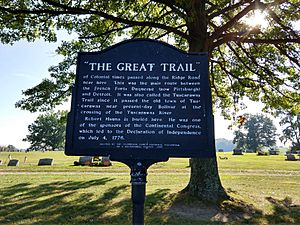Great Trail facts for kids

The Great Trail (also known as the Great Path) was a huge network of footpaths. These paths were made by Native American groups like the Algonquian and Iroquoian peoples. They used these trails long before European settlers came to North America.
This amazing trail system connected many different areas. It linked New England, eastern Canada, and the mid-Atlantic regions. It also reached the Great Lakes area. Today, many major highways in the Northeastern United States follow these ancient routes. This shows how important these trails were for travel thousands of years ago.
Contents
What Was the Great Trail For?
Even though some parts of the trail were called "warpaths," like the "Great Indian Warpath" in Chillicothe, Ohio, the main reasons for these trails were peaceful. People used them for trade, hunting, and gathering natural resources.
It's hard to say exactly where the Great Trail started or ended. There were many smaller trails that connected to bigger, more important routes. So, the Great Trail was more like a huge spiderweb of paths rather than one single road. This system also connected to the Overland Trail, which went further west, and other trails across the continent.
Parts of the Great Trail System
The Great Trail covered a very large area. Here are some of its important sections:
New England Trails
One part of the Great Trail system went through New England. It started in Passamaquoddy territory in northern New England. Then it went through the Lakes Region of New Hampshire. From there, it continued down to the Shawmut Peninsula in Massachusetts.
This section also connected to the land of the Wampanoag people near Cape Cod. It then linked up with the Nipmuc tribe's area around Lake Chaubunagungamaug. Finally, it reached parts of present-day Connecticut and areas further south.
The Mohawk Trail
Another important part of the Great Trail in New England is now followed by Massachusetts Route 2. This path goes from Boston all the way to upstate New York. The section known today as the Mohawk Trail was used by tribes like the Mohawk and Pocomtuc.
This trail went from the Connecticut River valley through the Berkshires mountains. It passed through the Mohawk Trail State Forest and ended near present-day Albany, New York. From Albany, the Great Trail system connected to all the lands where the Five Nations of the Iroquois Confederacy lived.
Trails in New Jersey
In northern New Jersey, the Lenape people used a part of the Great Trail a lot. This section had good places to cross the Passaic River. It also went through valleys in the Watchung Mountains, especially at Hobart Gap. When Dutch settlers moved beyond the Hudson River, they found these paths very helpful for their travels. Today, New Jersey Route 24 generally follows a branch of this ancient trail.
Trails to the Ohio River
A more southern part of the Great Trail system started in Delaware. It crossed Pennsylvania to Oldtown, Maryland. From there, it went to the Ohio River, just below present-day Pittsburgh. The trail then crossed Columbiana County to Bolivar and Sandusky, continuing west.
A part of the Great Trail that was used by American troops during Pontiac's War has been improved. It is now part of U.S. Route 23.
How Native Americans Shaped the Land
Just like Native Americans would burn underbrush to clear land for farming or to create open fields for deer, the Great Trail shows something important. It proves that the native people traveled widely and changed the land to fit their needs. These parts of North America were not an "untouched wilderness," as some early European settlers described them. Instead, they were actively managed and shaped by the people who lived there.

